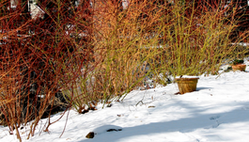
Deciduous trees and shrubs can have a stunning beauty in winter, a fine counterpoint to the heavier weight of conifers and other evergreens. Probably the best-known plants for winter stems are Cornus (dogwoods) which display a wide range of colors from bright yellow to dark red. We’ve inter-planted ‘Winter Flame’ with Cornus alba ‘Sibirica’ which has dark red stems, C. alba “Elegantissima’ whose white-variegated foliage provides a longer season of interest and C. sericea ‘Flaviramea’ whose greenish yellow stems provide a startling contrast.
Others to try include Cornus sericia ‘Cardinal’ which has vivid cherry-red stems, C.alba ‘Kesselringii’ has purplish stems (the dark color is great when used sparingly with lighter brighter cultivars) and C. alba ‘Aurea (gold leaves) and C. alba ‘Spaethii’ whose green leaves are margined with gold .
Dogwoods do best in moist, even wet soil and their winter color is most dramatic when they are planted in open sunny positions -- they can be spectacular around the margins of ponds. Ours however are in partial shade on top of a bank and have colored up fine in the winter. It’s the fourth year for this planting and the path is beginning to come into its own -- this spring I’ll cut them down to the ground again so they don’t overwhelm the path. The old wood should be cut out each year as it is the new wood that has the best color.
We have underplanted them with ferns, snowdrops, aconites, crocus, hellebores and amsonia hubrichtii -- I love the stunning orange and yellow foliage of this native. If space permitted it would be great to color theme the yellow and orange-stemmed selections with early narcissus, yellow crocus, aconites, mahonias and witch hazels. The reddish-stemmed cultivars would be stunning combined with the bronze foliage of Bergenia purpurasens, Hamamelis x intermedia ‘Diane’ and the pink-flowered Daphne bholua ‘Jacqueline Postill’. I already have these plants in our spring border and cannot find the room to add anything
 RSS Feed
RSS Feed
